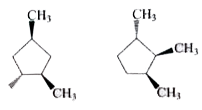For which of the following pairs of compounds are the correct notations given?




The correct Answer is:B, D
To solve the question regarding the correct notations for the given pairs of compounds, we will analyze each pair step by step.
Step 1: Analyze Pair A
- Notation Given: NT and Syn
- Explanation:
- Syn (or cis) indicates that substituents are on the same side.
- NT (or trans) indicates that substituents are on opposite sides.
- Observation: If both substituents (phenyl groups) are on the same side, then the correct notation should be Syn, not NT.
- Conclusion: This pair is incorrect.
Step 2: Analyze Pair B
- Notation Given: Syn
- Explanation:
- In this case, we have H and OH groups.
- If both H and OH are on the same side, this is indeed a Syn addition.
- Observation: The representation shows H and OH on the same side.
- Conclusion: This pair is correct.
Step 3: Analyze Pair C
- Notation Given: Anti
- Explanation:
- Anti indicates that substituents are on opposite sides.
- Observation: If H and OH are on opposite sides, this is indeed an Anti addition.
- Conclusion: This pair is correct.
Step 4: Analyze Pair D
- Notation Given: Cis and Trans
- Explanation:
- Cis indicates that substituents are on the same side.
- Trans indicates that substituents are on opposite sides.
- Observation: If HH are on opposite sides, it is Trans, and if they are on the same side, it is Cis.
- Conclusion: This pair is correct.
Step 5: Analyze Pair E
- Notation Given: E and Z
- Explanation:
- E indicates that the higher precedence groups are on opposite sides.
- Z indicates that the higher precedence groups are on the same side.
- Observation: If the higher precedence groups are on the same side, it is Z; if they are on opposite sides, it is E.
- Conclusion: This pair is correct.
Final Conclusion
- The correct pairs with their notations are:
- B: Correct (Syn)
- C: Correct (Anti)
- D: Correct (Cis and Trans)
- E: Correct (E and Z)
- Final Answer: The correct notations are for pairs B, C, D, and E.
- Notation Given: NT and Syn
- Explanation:
- Syn (or cis) indicates that substituents are on the same side.
- NT (or trans) indicates that substituents are on opposite sides.
- Observation: If both substituents (phenyl groups) are on the same side, then the correct notation should be Syn, not NT.
- Conclusion: This pair is incorrect.
- Notation Given: Syn
- Explanation:
- In this case, we have H and OH groups.
- If both H and OH are on the same side, this is indeed a Syn addition.
- Observation: The representation shows H and OH on the same side.
- Conclusion: This pair is correct.
- Notation Given: Anti
- Explanation:
- Anti indicates that substituents are on opposite sides.
- Observation: If H and OH are on opposite sides, this is indeed an Anti addition.
- Conclusion: This pair is correct.
- Notation Given: Cis and Trans
- Explanation:
- Cis indicates that substituents are on the same side.
- Trans indicates that substituents are on opposite sides.
- Observation: If HH are on opposite sides, it is Trans, and if they are on the same side, it is Cis.
- Conclusion: This pair is correct.
- Notation Given: E and Z
- Explanation:
- E indicates that the higher precedence groups are on opposite sides.
- Z indicates that the higher precedence groups are on the same side.
- Observation: If the higher precedence groups are on the same side, it is Z; if they are on opposite sides, it is E.
- Conclusion: This pair is correct.
- The correct pairs with their notations are:
- B: Correct (Syn)
- C: Correct (Anti)
- D: Correct (Cis and Trans)
- E: Correct (E and Z)
- Final Answer: The correct notations are for pairs B, C, D, and E.
Similar Questions
Knowledge Check
- Question 1 - Select One
Which of the following pairs of compounds are not isomers?
APropan-1-ol and methoxyethaneBPropene and cyclopropeneCpropyne and propadieneDpropyne and cyclopropene - Question 2 - Select One
Which of the following pairs of compounds are not position
isomers?A B
B C
C D
D
- Question 3 - Select One
Which of the following pairs of compounds are not positional isomers ?
A B
B C
C DAll of these
DAll of these
Which of the following pairs of compounds are not isomers:-
View SolutionThe following pair of compounds are best described as
 View Solution
View SolutionWhich of the following pairs of compounds are position isomers?
View SolutionWhich of the following pairs of compounds is a pair of enantiomers?
View SolutionWhich of the following pairs of compounds are functional isomers?
View Solution

